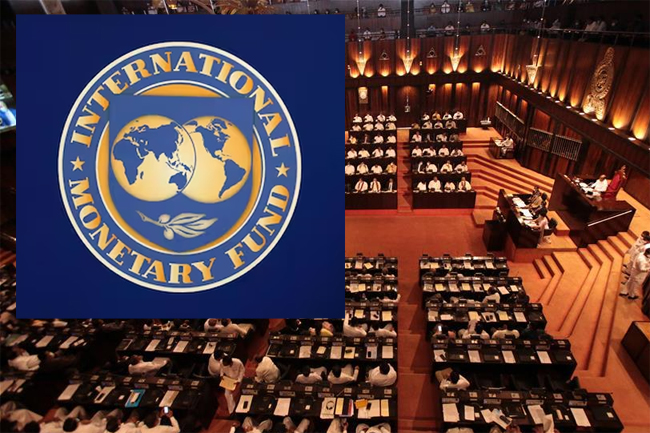Any delay in reaching an agreement on Sri Lanka’s external debt restructuring will be a killer for the country, which will have to sacrifice all the hard-earned gains so far relating to pushing the country back to normalcy, warned independent economic analyst Dr. W.A. Wijewardena, in an interview with The Sunday Morning. “The ideal outcome should entail a massive haircut of about 51% of the bilateral and commercial borrowings of Sri Lanka,” he added.
While the Government is aiming for a September completion of the debt restructuring process – a deadline which was earlier set for June – Dr. Wijewardena said the outcome depended on whether Sri Lanka would get sufficient debt relief from all its creditors to make its foreign debt sustainable.
“As it is, the likely outcome will be a postponement of the repayment date beyond 2027, the last year of the present Extended Fund Facility (EFF) with the International Monetary Fund (IMF). But by this time, Sri Lanka’s debt obligations to the IMF will also rise to $ 2.9 billion if the country gets all the remaining EFF tranches as scheduled and meets all the debt servicing obligations to the IMF in time. What this means is that Sri Lanka may have to go for another IMF facility in 2028 to get out of the problem. But it is a ‘borrow-live-borrow’ cycle that enhances the debt stock, which is not the ideal solution,” added Wijewardena, who is a former Deputy Governor of the Central Bank of Sri Lanka.
In the course of the interview, he also spoke on the Macro-Linked Bond (MLB) proposed by the Ad Hoc Group of Bondholders, the suggested Governance-Linked Bond (GLB), the Government’s negotiations with the Official Creditor Committee (OCC) of Sri Lanka’s bilateral creditors, China’s role in finalising bilateral debt, the Asian Development Bank (ADB) forecast for Sri Lanka’s economy, and the Government’s move to introduce an ‘economic transformation act’.
Following are excerpts of the interview:
In the Government’s ongoing discussions with private creditors, the two parties have so far been unable to reach a consensus and the latest proposals by the private creditors presented earlier in April are currently being assessed by the IMF. What is your overall assessment of Sri Lanka’s debt restructuring process and efforts to finalise the debt restructuring programme, as things stand?
It is crucial for Sri Lanka to reach a permanent solution to its overhanging external debt. What is being restructured is only two of the debt sources contracted by the Central Government. The total country debt as at end-2022, which includes those of the Central Government, Government corporations, the Central Bank, and the private sector, had amounted to $ 58 billion. This is the total liability of the nation to foreigners and all these loans should be repaid in foreign exchange.
Of this only, the borrowings by the Central Government from the individual creditors – called bilateral creditors – and from commercial markets and under commercial conditions have been listed for restructuring. That had amounted to $ 27 billion or 47% of the total country debt. In the case of the Central Government, what had been borrowed from international financial institutions like the ADB, World Bank, or International Fund for Agricultural Development (IFAD) and what the Central Bank had borrowed from the IMF, amounting to about $ 11.5 billion, had been excluded from restructuring, since, in terms of the agreement with those agencies, Sri Lanka cannot default on payments without being blacklisted for further borrowing.
These loans should be repaid irrespective of whether Sri Lanka has or has not reached agreement with bilateral and commercial creditors. These loan repayment commitments will amount to about $ 1 billion per annum according to IMF estimates. But the actual payments made in 2023 had been about $ 1.9 billion. This is a continuing drain on the scanty foreign exchange resources of the country.
A country should gain capacity to repay its foreign debt by increasing net foreign exchange earnings through the export of goods and services, which are permanent sources of foreign exchange earnings. In this context, remittances and Foreign Direct Investments (FDIs) are temporary gains, which can be reversed at any moment if there is an unfavourable global condition like a pandemic or a regional war.
This gap is very large for Sri Lanka and the IMF has estimated it to be about $ 25 billion during 2022-’27. Of this, the IMF expects at least $ 14 billion by way of debt relief during this period. This amounts to about 51% of the debt to be restructured and this is the haircut which Sri Lanka should get from both the bilateral and commercial creditors if the country is to reach an external debt sustainability level. Any other arrangement will simply postpone the debt liability to a date beyond 2027. What is being bargained for is much less than this.
While noting that it is not a relief for Sri Lanka, the Government’s initiative to reach some agreement with them should be upheld. Hence, any delay in reaching an agreement will be a killer for Sri Lanka, which will have to sacrifice all the hard-earned gains so far relating to pushing the country back to normalcy.
What would an ideal outcome entail in terms of a viable debt restructuring with commercial and bilateral creditors?
As mentioned above, the ideal outcome should entail a massive haircut of about 51% of the bilateral and commercial borrowings of Sri Lanka. According to the data collected by IMF, as at end-2022, Sri Lanka had owed $ 11.4 billion to bilateral creditors and $ 19 billion to commercial creditors if a swap facility of about $ 2 billion contracted by the Central Bank is not taken into account.
It is useful to know the composition of these two categories. Of the bilateral debt of $ 11.4 billion, the country had owed $ 4.8 billion to Paris Club members, with $ 2.8 billion to Japan, $ 4.5 billion to China, and $ 1.8 billion to India. Accordingly, any agreement with Paris Club members including India will cover only $ 6.6 billion. If China agrees with the Paris Club agreement, even with a 100% haircut, Sri Lanka cannot meet the gap of $ 14 billion envisaged to be filled during 2022-’27.
Of the commercial credit, International Sovereign Bond (ISB) holders own $ 13.4 billion, including the arrears which had been added to them during April-December 2022. In addition, Sri Lanka owes $ 2.9 billion to China Development Bank and a further $ 200 million to other creditors. What is being negotiated in London – known as the London Club, because it is in London that these commercial borrowings are handled – with the Ad Hoc Group amounts only to 50% or $ 6.5 billion.
The haircut that Sri Lanka should get from both the bilateral and commercial creditors should be at least $ 14 billion if it is to be the ideal outcome. We all know that this is not possible and, hence, Sri Lanka should have haircuts from other creditors excluding multilateral creditors to meet its forex gap during 2022-’27.
The Government initially said the process would be completed by June but has now postponed the target date for September. Do you have faith that an agreement will be reached by September?
Nothing is impossible, but it all depends on whether Sri Lanka will get sufficient debt relief from all its creditors to make its foreign debt sustainable. As it is, the likely outcome will be a postponement of the repayment date beyond 2027, the last year of the present EFF with the IMF. But by this time, Sri Lanka’s debt obligations to the IMF will also rise to $ 2.9 billion if the country gets all the remaining EFF tranches as scheduled and meets all the debt servicing obligations to the IMF in time.
What this means is that Sri Lanka may have to go for another IMF facility in 2028 to get out of the problem. But it is a ‘borrow-live-borrow’ cycle that enhances the debt stock, which is not the ideal solution.
Sri Lanka has expressed its reservations about the Macro-Linked Bond (MLB) that has been proposed by the Ad Hoc Group of Bondholders. What is your view on the MLB?
The MLB proposal would have been a good proposal to accept. But since it means that the fruits of better economic performance than what the IMF has predicted should be shared with bondholders, Sri Lanka may be unwilling to do so due to two reasons.
One is that if accepted, other bilateral creditors too might ask for a similar facility. The other is that Sri Lanka expects with certainty that it will outperform IMF predictions during 2023-’27. So, as a precaution, the country would have rejected it. This is a totally selfish move and that is not the way you negotiate with your creditors.
The possible introduction of a Governance-Linked Bond (GLB) has also been suggested. How do you view this proposal?
This is a new proposal to be tried by Sri Lanka, or for that matter by any other country in the globe, as a debt restructuring instrument for the first time, providing a precedent to the rest of the world. It helps Sri Lankans to force their Government to implement good governance proposals suggested by both the IMF’s Governance Diagnostic Assessment and Civil Society’s Governance Diagnostic Report, released almost simultaneously in September 2023.
From the citizens’ point of view, it is a positive proposal. But it will not enhance the country’s capacity to meet its foreign debt obligations in the future. It is not a debt sustainability measure but a debt management measure for the time being.
The Government’s negotiations with the Official Creditor Committee (OCC) of Sri Lanka’s bilateral creditors are proceeding in a positive manner, according to the Government, which says it is only a matter of deciding whether there is going to be a single agreement with the OCC or individual agreements with each member state. What would you recommend as the best approach and why?
We should note that whatever the agreement to be reached is not adequate for Sri Lanka to gain foreign debt sustainability since the country’s debt liability is several times the amount to be restructured. The country will simply increase its debt stock to refinance the same.
Given this shortcoming, I believe that it is better if China is also brought to the table along with the OCC and a common agreement is signed with both parties. It will ensure the comparability principle enshrined in debt restructuring processes.
China’s role in finalising the bilateral debt remains key. How should Sri Lanka handle this?
Yes, without China on board, Sri Lanka cannot have a permanent solution to its debt problem. Ever since Sri Lanka signed the Rubber-Rice Pact in the early 1950s with China, ignoring the punitive objections placed by the US, that country has been a friend of Sri Lanka. In 1956, Sri Lanka established formal diplomatic relations with China and in 2026, it will have its 70th anniversary of unbroken, friendly relationship.
China also highly respects the father of the present Prime Minister, Dinesh Gunawardena. Sri Lanka should use these friendly sentiments to get a better deal from China than the one to be received from the OCC. What this means is that it is a Herculean diplomatic mission which Sri Lanka should have with China in the years to come.
There have been charges of a lack of transparency related to the restricted discussions the Government held with the Ad Hoc Group of Bondholders. How should the Government address this?
It is unfortunate that Sri Lanka has left room for the Ad Hoc Group to make this accusation. In my view, it is something that should not have happened. Unless both parties trust each other, there cannot be a long-lasting workable solution to the problem. Hence, in the name of reaching a pragmatic solution, Sri Lanka should maintain transparency in its negotiations with all the parties.
According to the ADB, Sri Lanka is showing signs of recovery and in its ‘Asian Development Outlook’ (ADO) for April, the ADB has forecasted Sri Lanka’s economy to record moderate growth of 1.9% in 2024 and 2.5% in 2025 following two consecutive years of contractions. What is your view?
Sri Lanka’s historical average growth rate is 4% and it is akin to the 2% growth attained by India prior to economic reforms which had been nicknamed ‘Hindu Rate of Growth’ by development economists. By the same token, this 4% growth that can be called ‘Lion’s Growth Rate’ is something which the country can attain without undertaking any policy strategy. Hence, any growth rate below this historical average is a negative growth rate for me.
Both the IMF and World Bank too have predicted similar low growth rates for Sri Lanka until 2027. Hence, this low growth, after six consecutive quarters of negative growth, is not something to be rejoiced over as had been done by some Government supporters.
What are your thoughts on the Government’s move to introduce an ‘economic transformation act,’ which supposedly envisions transforming Sri Lanka’s backward economy into a modern, robust economy?
The details of the economic transformation act have not been revealed by the Government. Previously in June 2023, addressing the nation, President Ranil Wickremesinghe pronounced that his Government would follow the growth lab approach to strategise the action to make Sri Lanka a developed country by 2048. This is a technique developed by the Center for International Development of Harvard University’s Kennedy School of Government.
Wickremesinghe said that he would assemble a growth lab with top private sector leaders, bureaucrats, and Cabinet ministers in July 2023 to design suitable strategies and these strategies were to be presented to the people in September 2023 for their approval. The outcome was to have been released in the form of a national transformation plan in January for adoption.
Since none of the milestones in the lab approach have been met, the national transformation plan has become a non-event. But now the Government has announced that it will present a narrower version of a national transformation plan in the form of an economic transformation act for approval by Parliament.
Cabinet Co-Spokesman and Minister Dr. Bandula Gunawardana recently revealed that the Cabinet had approved the draft economic transformation act containing a few bureaucratic reforms. According to him, an economic commission will be set up by amalgamating the Board of Investment (BOI), Export Development Board (EDB), and Industrial Development Board (IDB), provisions will be made for establishing economic zones of investment, there will be an international trade office to negotiate trade agreements, an international trade institute will be formed to study issues relating to international trade, and a national productivity commission will be established to improve the country’s productivity.
These are all bureaucratic reforms and their ability to push the country’s growth to a higher level without concrete action to promote private investment is rather limited. Hence, the economic transformation act should be followed by a comprehensive national economic plan to give full benefits to Sri Lanka.





